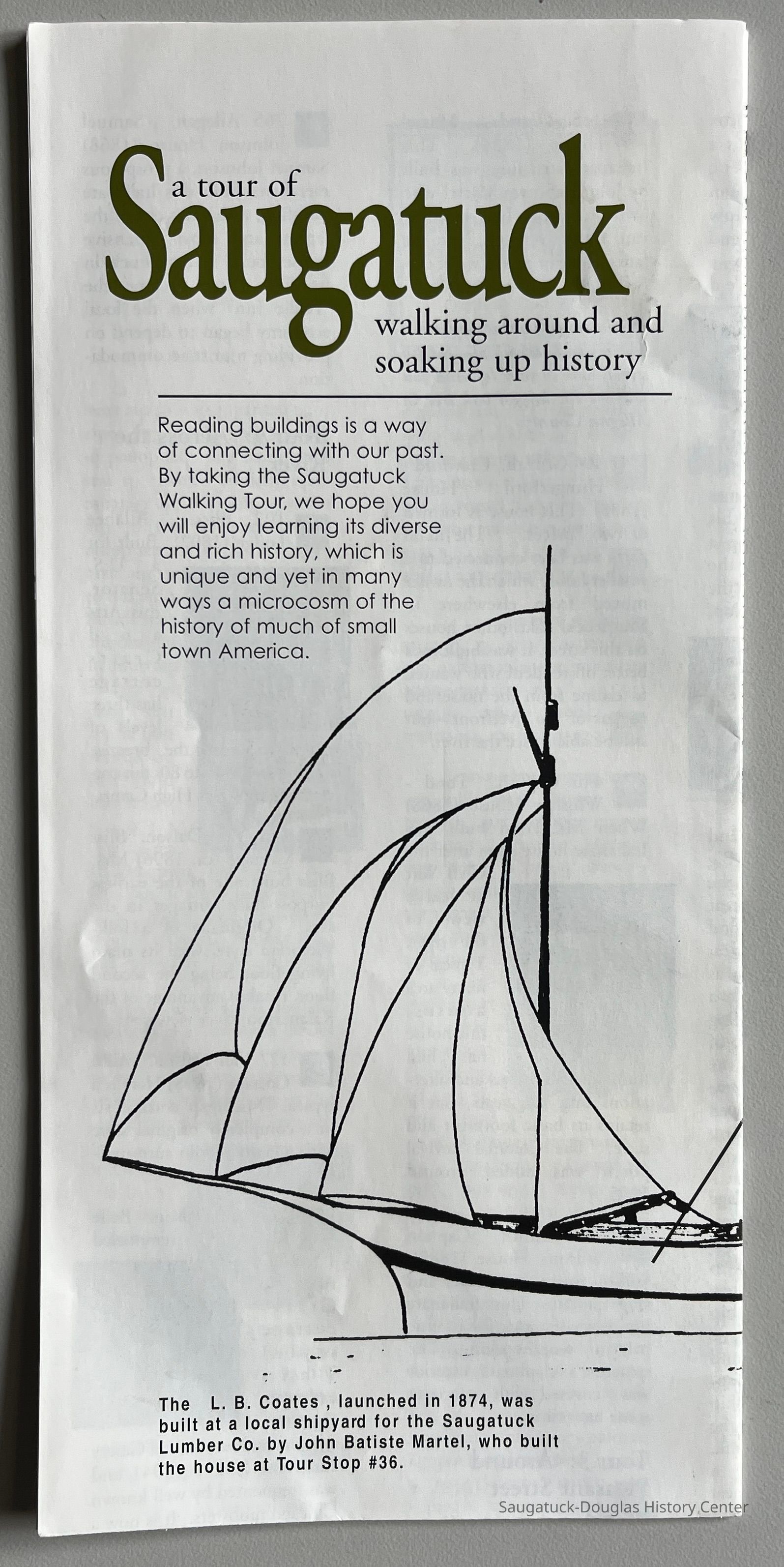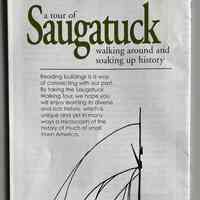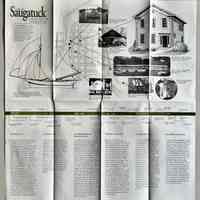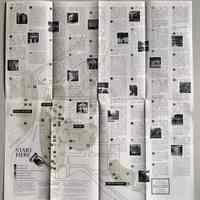A Tour of Saugatuck

2023.18.46
A circa 2001 project by the SD Historical Society to raise awareness of history and architecture. Hillman was a member of the Saugatuck Historic District commission. This brochure mentions the book "Raising the Roof: The Buildings and Architecture of Saugatuck-Douglas."
Buildings: CommercialBuildings: Homes, cottages and private residencesBuildings: LostSDHS Publications
Winthers, Sally
2023.18
Found in Collection
flat, unfolded
18 in
17 in
159 Walking/Trolley Tours
Mount Baldhead Dune/Park
The Pioneer Era Before 1830, the Saugatuck area and most of Allegan County were inhabited solely by the Pottawatomie Indian tribe. European incursion into the area was limited to the French Voyageurs who trapped for furs and traded with the Indians. The earliest settlers were people who came to work and make their fortunes primarily from the area's natural resources--pine trees for lumber and shingles, hemlock trees to use in tanning hides, land specula-tion, fishing, and, later, fruit growing. The first settler, William Butler, arrived with his wife at the mouth of the Kalamazoo River in 1830. He platted a village on the small level area, known as "the flats", at the foot of a clay bluff. By the 1850s, Saugatuck was flourishing, mainly by selling lumber products to Chicago. Most of the public spaces were taverns and boarding houses. Generally most buildings during the early period were extremely modest or primitive cabins and many people lived in other people's homes, boarding houses, or hotels. Virtually everything was built on the flats. But by the 1850s, Saugatuck began to take on a cultivated look. The prevailing architectural style was Greek Revival-popular because it was simple to build, affordable yet architecturally stylish. The Lumber Era This was the golden age of building in Saugatuck. The economy was booming. Steamboat service between Chicago and Saugatuck started in 1867. Eight lumber mills were going full-blast to meet growing urban needs, especially Chicago's after the Chicago fire of 1871, and the population increased three-fold. New buildings to meet this population increase were built primarily "on the hill," away from the flats, which had become a noisy, rowdy, congested area of workers, sailors, and bars. Also during this period, the first public spaces were built: churches, the city hall, and fraternal order lodges. The Italianate style in building became popular during this period. The Shipbuilding and Fruit Growing Era By 1880, the lumber boom was over after round-the-clock clearcutting and milling had finished off Michigan's famous white pines. The Village of Singapore, near the mouth of the river, folded and many other area mills closed down. Their owners and workers moved on to find new fortunes elsewhere. But as old industries were dying, new industries were starting. Fruit growing replaced lumber as the area's premier natural resource and Michigan peaches were known as "Michigan Gold" in Chicago. By 1884, there were 134,812 trees under cultivation in Saugatuck, Douglas, and the surrounding area, producing nearly a quarter of all the peaches grown in Michigan. Boat building and shipping also expanded during the peri-od. In 1871, 672 vessels entered the port of Saugatuck. More than 200 vessels were built here between 1880 and 1910. With this influx of new capital and new people, the town grew and more stylish homes were built. Many were built by ship captains or people involved in boat building. Many of these homes still stand, but the best known and most stylish of these captain's houses was unfortunately torn down in 1967 to make way for a parking lot. The Back to Nature Era By the end of the 19th century, Saugatuck and the surrounding area were starting to see hard times. The years between 1895 and 1920 saw the demise of the boat building industry and most of the vast peach orchards. With this came a substantial decrease in population. By 1920, Saugatuck's population had fallen below that of 1870. But once again, luck would provide Saugatuck with a new source of income which, although seasonal, has persisted to the present day--tourism. By 1900, Americans had discovered leisure and tourism, including the "get-away-from-it-all" cottage, in a big way and Saugatuck was benefiting from this new trend. The lake, river, and forest, which had previously been viewed as dangers to be traversed or something to be exploit-ed, now came to be viewed by city folks as objects of beauty and as moral and spiritual antidotes as well. During this period, a new architectural style, Arts & Crafts became popular, reflecting a more friendly and more spiritual view of nature- as it stressed simplicity of form, honesty of materials, the virtue of hand craftsmanship, and a respect for the natural environment. The Big Pavilion Era In the aftermath of WWI, while much of America was in a boom period, small town Michigan was not. Saugatuck's economic base, with the exception of seasonal tourism, had all but disap-peared. The upside of this story for us today is that this slow economy meant Saugatuck's old-fashioned, quaint character remained intact. By 1920 Saugatuck was looking a bit shabby and out of date. To increase its tourist business and attract new seasonal residents, Saugatuck paved its streets for the first time and prettied itself up by transforming many of its existing buildings with Colonial Revival facelifts, a style which was very popular in America after WWI. In doing this, it benefited from the local summer presence of architects of national stature such as Thomas Eddy Talmadge, Robert Spencer, George Hellmuth, and George Maher, as well as local architect Carl Herman. New construction also reflected this Colonial Revival trend, with the Arts & Crafts movement continuing to have a strong presence. Post WWII to the Present During these years, Saugatuck's image as a quaint resort community became solid-ified. During the 1950s and 1960s, most of the new construction to house the increasing flow of tourists occurred in Douglas and the surrounding township since Saugatuck was already quite built-up. These buildings were pretty typical of modern construction seen everywhere in suburban America. But in the 1970s, Saugatuck began to see a new wave of both tourists and part-time residents who had more money to spend. Many of these people were drawn not just to the water or the woods, but by a desire for "real" and "genuine" experiences within "natural" or "historic" environments. This has had a major impact, both on the preservation of the existing built and natural environment of the area, but also in the construction of new homes which, for the most part, are compatible with the surrounding streetscape in their size, scale, and use of materials.
11/30/2023
03/31/2024



